ASTRO CITY #1 ($3.99, Vertigo)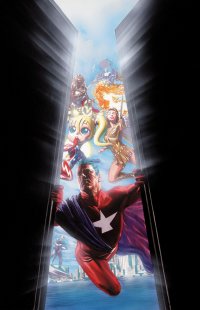
By Adam Prosser
One of the most intriguing themes of Kurt Busiek and Brent Eric Anderson’s Astro City–highlighted particularly in the recent, epic “Dark Age” storyline–is the way superhero comics provide an astoundingly clear window into the fears, hopes and dreams of a particular cultural moment. In that storyline, which drew heavily from Bronze Age comics (Marvel’s in particular), we were reminded of how stories like Captain America renouncing his identity in the wake of Watergate, the rise of characters like Power Man and Iron Fist, or the collision between trippy cosmic epics and “gritty” street-level stories provided such a perfect snapshot of the pop culture of its day. Busiek did something similar, of course, with Marvels, which was the original inspiration for Astro City in the first place.
But one of the reasons Astro City was launched, back in the mid-90s, was to remind a comic book industry then mired in GRIMDARK just how much power (and entertainment value) there was in classic comics, positing an alternate superhero universe in which, after a decade and a half of edginess, the superhero paradigm returned to a sense of wonder and optimism in 1986 with the arrival of The Samaritan. Since 1986 was, in our world, the exact point where superheroes started to get MORE “grim and gritty”, to an absurd degree, Astro City has therefore always been deliberately out of step with its times.
But Astro City launched almost twenty years ago (!) and our culture’s changed significantly since then. Since the world of Astro City is meant to change alongside it, it’s not surprising that we’d eventually see some cultural signifiers show up, as they do here, in the long awaited new issue (making this the third, possibly fourth time this series has relaunched…) The most notable is the character of American Chibi, whose name pretty much sums her up: she’s a bobble-headed, anime-eyed spastic fangirl with superpowers. Of course, you can argue that a Japanese-inspired character is about ten years out of step as well, but it’s still within the ballpark, though I did like the snide speculation on her origins, which included the possibility that it was a 35-year-old male nerd in disguise. Arguably more interesting is the narrator of this issue, a strange photo-negative creature who calls himself The Broken Man and seems to have some kind of metatextual awareness–he’s narrating the story to us even as he’s attempting to influence events in some yet-unexplained way against something called the “Oubor”, whose influence he sees everywhere. He even wears an Astro City T-Shirt. You can’t get more contemporary than a meta conspiracy theorist!
Plotwise, the story marks a surprising return to one of the earliest issues of the series (the first of the regular ongoing, in fact) that told the story of a man named Ben Pullam who’d just moved to Astro City with his two daughters. We’re reunited with a 17-years-older Ben (seriously, !!!) who finds himself at a crossroads now that his daughters are grown and he has enough money that he doesn’t need to work, yet isn’t ready to retire. Opportunity knocks, or rather, comes bursting through the door…the door being a gigantic, mysterious portal that manifests itself over Astro City that opens to reveal a Kirby-esque cosmic figure calling himself Telseth. He wants to understand Earth from the perspective of a normal human being–not a superhero or a high-placed government agent–and Ben fits the bill perfectly.
It’s so good to have this series back, man. The break seems to have done Busiek good, too–this new issue feels fresh and original, like the series is headed in a new direction. The Broken Man is an interesting, unusual character for the series, and both he and Telseth seem to reflect, as I say, a desire to go meta. This series has always switched in tone between the more intimate, subdued and “realistic” scenes and the larger, more traditional comic book moments, but here there’s a more tongue-in-cheek self-awareness to the “comic book” scenes as well, reflecting the snarky, Joss Whedonesque tone of modern comics. There’s even some fractured, overlapping dialogue that seems to be a nod to Brian Michael Bendis. (Don’t worry, it’s just a panel or two.) I would have been delighted just to get more of the same when it comes to this series, but this issue makes it clear that Busiek and Anderson want to keep moving forward stylistically as well. The world of Astro City never stands still; why should its creators?
Rating: 




Out of a Possible 5 Stars
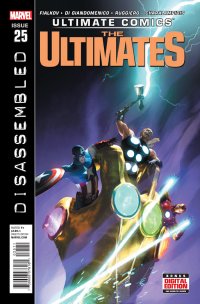 Ultimate Comics The Ultimates #25 (Marvel, $3.99)
Ultimate Comics The Ultimates #25 (Marvel, $3.99)
By Graig Kent
Apparently, outside of the rather fantastic and rock-solid Ultimate Spider-Man, the Ultimate Comics side of the Marvel Universe isn’t doing so well right now. Fan interest is waning, The Ultimates and Ultimate X-Men are struggling to crack the top 100 every month, and a sharp drop in sales immediately after their relaunch 2 years ago has yet to really level off. It couldn’t have been all that bad, really, Jonathan Hickman graduated from the Ultimates to the real Avengers, while Nick Spencer went over to Secret Avengers after the first year, so it’s not necessarily their fault. So what is it, why is the Ultimate Universe (again, Miles Morales excepted) no longer holding any traction with fans? This was afterall the universe from which the template of the modern Marvel movie series was spawned.
Cracking open Ultimate Comics The Ultimates #25, the problem becomes quickly apparent. A straight-jacketed Bruce Banner is hooked into a monstrous manga-fied contraption via a collar around his neck, a poisonous injection threatening him should he turn into the Hulk. An interloper manages to find his way into the improbable cell and free Banner, thus loosing the monster once more. Isn’t this kind of where the Ultimates started off 12 years ago, the Avengers against the Hulk? Only this time, the Hulk has another ally in the form of the tumorous-looking Reed Richards, each now donning an Infinity Gauntlet that the Ultimates shamelessly didn’t take the opportunity to use against them. Hulk and Reed Richards are the bad guys here. The heroes are the villains. That’s got to be a problem for many readers.
The Hulk has long been a shade-of-gray character, but in the Ultimate universe, he can easily be jet black, a selfish, petulant rage monster that is not the least interested in helping anyone but himself. Reed Richards, meanwhile, in the opening arc of this series by Jonathan Hickman was presented as a man who has expanded his brain to the point of intellectual superiority, in turn losing anything resembling an emotional connection to modern society. He wasn’t an outright villain in Hickman’s hands, but something cold and distant, attempting to serve humanity while not understanding how he had destroyed his own. But here, both are presented as little more than opponents for the Ultimates to fight and lose to.
As a casual Marvel reader, I find it’s generally easy enough to step into most of the typical Marvel Universe titles. Even with dramatic changes there’s still a consistency or status quo that’s maintained so as to make entry accessible enough. Stepping into a Captain America comic, only to find that it’s Bucky in the costume and Cap’s dead, fair enough, you’re still going to find Captain America-style stories therein. The Ultimate universe has become a place where things happen. Characters die, and stay dead, Washington can get nuked and the country factions off. The Ultimate version of the X-Men and Avengers both have members of the Fantastic Four on their teams. And the good guys, well, they’re not always acting like good guys, some of them barely ever act like good guys, and some of them are the bad guys. It can be a very confusing place to just step into. I’ve only been gone from The Ultimates for 12 issues and I found stepping into this issue to be both unpleasant and distancing as a reader.
The fact that the Ultimate Universe can progress and evolve and be an independent universe from the regular Marvel universe, as well as distance itself from being a reflection of our own (which most ongoing universes still attempt to do despite the vast differences in reality) should be one of its strengths, and in the right hands it is. Hickman’s rather grandiose, world-changing arc was a literal Marvel, taking advantage of every aspect the Ultimate universe affords. Same with Bendis’ new Ultimate Spidey, who in the normal Marvel U would shine for but a brief time until Peter’s inevitable resurrection before being relegated to second-stringer once more. But for most writers instead it seems to have become an increasing liability, a weight of 10 years of Ultimate continuity that they get lost in or they fall into the trap of trying to Ultimate-ize events from the 616, as is the case here.
This is the start of “The Ultimates Disassembled,” an obvious play on the “Avengers Disassembled” arc from the mid-aughts, but, if rumours are true, it’s heading headlong into the rebirth and/or annihilation of the Ultimate Universe. Joshua Hale Fialkov takes over for Sam Humphries with this issue but it feels less a fresh start than a continuation, which I guess works in the favour of the shrinking readership but it doesn’t create a welcoming starting point for new readers. Fialkov is a good, frequently great writer, but he seems like he’s still searching for a handle on the characters, as well as dealing with a story that’s more editorially mandated than something of his own devising.
The art for The Ultimates has, for a long time, been Event-level art. Bryan Hitch, Joe Madureira, Frank Cho, and even Esad Ribic held up to this standard at the start of this series, but the art team of Carmine Di Giandomenico and Lorenzo Ruggiero just doesn’t hold up to that standard. It’s perfectly serviceable, but I think what had made The Ultimates so impressive, or at least worth paying attention to, was the grand scale of the art, intricate and widescreen. Di Giandomenico and Ruggiero are missing that epic feeling.
I’s possible this story will serve as an important step towards the bigger scheme of the Ultimate Universe (“HUNGER” as the promos proclaim) but more likely it’s just biding time, filling the schedule until the Event arrives.
Rating: 




Out of a Possible 5 Stars
Pacific Rim: Tales from Zero Year ($19.99, Legendary)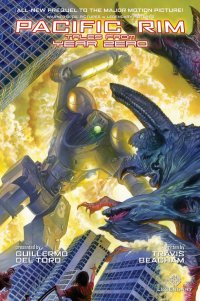
by D.S. Randlett (@dsrandlett)
If you’re following a site like CHUD, you’re probably aware of site (and personal) favorite Guillermo Del Toro’s forthcoming film. Despite the trailers and good word, this is a project that hasn’t quite felt real to me, like the build up to Pacific Rim is in and of itself a fiction or a glimpse into a parallel universe where Hollywood makes movies like that. I suspect that part of it has to do with the fact that so far Warners/Legendary has been selling the concept, the idea of an apocalyptic giant monsters vs. giant robots film and not so much the story. Which makes jumping into this rather good prequel GN a rather jarring experience. All of a sudden, these ideas we’ve been sold feel a little more tangible, the world and thematic meat a little more comprehensible. Likely for the first time, the world of Pacific Rim feels like an honest to god story.
Most movie tie-in comics are either straight up adaptations of some variation of a movie’s script or a loosely related story that whets the appetite and builds the world a little. The recent Man of Steel tie-in falls into this latter category, presenting a romp through Kryptonian society which will likely have little bearing on the core story of the film. But in terms of art it exists as this weird sort of limbo product, and as such just doesn’t feel like a complete experience, or in the case of adaptations an unrefined experience.
Pacific Rim manages to avoid many of these pitfalls for a few reasons. One is the advantage of an original world. Something like Man of Steel carries a certain set of expectations in terms of its narrative, especially as an origin story, so any “prequel” (ugh) material can’t tread on the main character’s primary arc. With Pacific Rim, those expectations don’t exist, so this GN is more or less free to be its own thing. The other advantage that this comic has going for it, and the most important one, is the story’s humane eye for its characters.
If Travis Beacham’s screenplay takes the same approach as his script for this comic, we’re in for something of a treat later this summer. The stories (three recollections of the first year of monster attacks) do center around giant monsters and the robots who punch them, but the narrative constantly maintains a human-sized focus. The first and weakest of the stories, chronicling the first kaiju attack on San Francisco, is a lot like Cloverfield in that it represents a ground-eye view of an attack like that, but its human drama is more keenly felt. The other two stories concern themselves with the development and piloting of the Pacific Rim universe’ Jaegers, and they both represent some rather good science fiction, establishing the Jaeger technology and examining the toll that this new technology takes on the souls who have to use it. For a movie that’s being hyped as a crazy bash, this comic is setting the stage for some compelling small stage storytelling. Of course, even divorced from the coming film, this is still a very well written comic full of ideas, both large and intimate.
The art does not come off so well as the writing. The multiple artists that have worked on this book are fine, but there’s often a failure to strike the same balance that the script does, or even a feel for this world. It’s not terrible, just not noteworthy.
If you are looking forward to the Pacific Rim film, this is well worth a look as a quality movie tie-in. But it also succeeds as its own story, regardless of its connections. If you’re a fan of good science fiction, check it out.
Rating: 




Out of a Possible 5 Stars
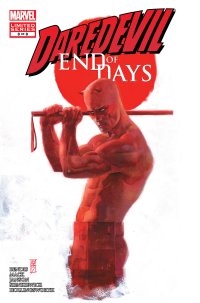 Daredevil: End of Days #8 of 8 (Marvel, $3.99)
Daredevil: End of Days #8 of 8 (Marvel, $3.99)
By Jeb D.
TV reviewers who are lately bemoaning the difficulty of covering that medium, in an era where binge-watching runs neck and neck with serialized viewing of series, are just dealing with the reality that comic reviewers have been battling for years: balancing the needs of an audience taking in a story a chapter at a time, with one that waits to consume it in one go. That’s a particularly tricky balancing act when a story is focused around answering a fairly specific mystery: is it enough to say whether the solution is satisfying? Does the effectiveness of that destination alter the perception of the journey to get to it? The choice is always there: is this a “review”, that gives new readers a quick thumbs-up or down about the book in question, or is it a “critique” that allows those who have read it to engage in specific analyses of what works and what doesn’t? In the end, I guess I come down on the side of the former: Daredevil: End of Days is worth your time, however you choose to read it, so I might as well leave you as unspoiled as possible.
The spirit of Frank Miller hangs over End of Days, just as it does most modern incarnations of Daredevil: not only was “Born Again” the story that pretty much created the character afresh, but Miller’s The Dark Knight Returns was, if not the first, certainly the most influential, story of a post-“heroic” superhero character in a darker, post-superheroic world. Writers Brian Bendis (mostly) and David Mack (who doesn’t seem to have much to do these days besides these guest appearance in Bendis books) take the rest of their cues from Citizen Kane, with reporter Ben Urich the eyes through which we view the story of Daredevil’s death, and its aftermath, by interviewing, and interacting with, the people who, for good or ill, influenced, and were influenced by, Matt Murdock’s life; and, of course, Welles’ film was the inspiration for shaping the central mystery around Matt’s dying word: “Mapone.”
The journey through End of Days has, for the most part, been a satisfying return to Bendis’ time on the monthly book: during his tenure, he grew Daredevil’s supporting cast into one of the strongest in the history of superhero comics, and End of Days gives readers the chance to revisit his versions of characters like J. Jonah Jameson, the Owl, The Gladiator, and the engagingly hopeless Turk. He’s also crafted a starkly scary version of The Punisher, different from Ennis’ or Rucka’s, but at least as effective. His use of Nick Fury (the original one, by the way: like Age of Ultron, this series has been so long in gestation that it practically feels nostalgic in comparison with the movie-driven changes in today’s Marvel Universe) stands out as being too cliched, though: the old spymaster periodically pops out of shadows to hint at secrets too dark for anyone but himself to handle, then disappears again. Layers of social observation reveal themselves more fully on a second reading: the vision of American society that Bendis has shaped here as a backdrop is as sobering as any of the brutality laid out on the pages.
But, of course, a winding journey like Ben Urich’s, filled with bitterness and disappointment (and worse, really, though not without a glimmer of hope) is hard to bring readers into without promises of revelation to drive the plot, and in this final issue, we do get the answer to “Mapone” (and I apologize that this is kind of a spoiler in itself, as Bendis hints, late in the book, that we’ll never know). It helps that Bendis began issue #1 with Daredevil’s death, so that we’re past any suspense (or lack of same) in that regard. I still regard the whole “Mapone” thing as being the series’ weakest aspect: blatantly “homaged” from Kane, it was like a constantly nagging itch: every choice dialog exchange, or perfectly realized page of art, would be interrupted with a figurative, or literal, query of “…but what about Mapone?” The constant drumbeat of repetition made it almost inevitable that the answer would be, not so much unsatisfying, as anticlimactic. And while I might have missed something during my quick re-read of the eight issues of the series today, I’m unclear how Bullseye was supposed to understand the significance of the word, or how that would drive him to his final act of unerring marksmanship. But given that sticking the landing has always been one of Bendis’ difficulties, I’d rate the conclusion to Daredevil: End of Days as being among his best.
Artist Klaus Janson was another (direct) link to Miller’s DKR, and with finishes from Bill Sienkewicz, he has made Daredevil: End of Days into the visual masterpiece of an already legendary career. There may be no single moment in issue #8 to match his incredible first appearance of The Punisher a few issues back, but the storytelling he brings to the story’s final page, with its melancholy sense of resolution, is cinematic perfection. I know that the various comics industry awards have been pretty Daredevil-heavy of late (I also recommend picking up the first issue of Lee Weeks’ new Daredevil: Dark Nights mini, out this week), so there may be a sense that it’s time to give someone else a chance, but this is visual comic storytelling of an extraordinary high order, and deserves to be recognized. David Mack’s contribution is his typically lovely, evocative, painted pages, focused on dream and memory; I honestly don’t think the story would have lost much without them, but if you want this kind of interlude in a comic, no one delivers better than Mack.
Daredevil: End of Days was promised, reworked, started, and delayed, so many times, that some readers may feel that time has passed it by: Mark Waid’s current run on the monthly title is the first since Bendis’ departure to truly find its own way, honoring what Bendis did with the character while never forgetting that Daredevil began as just another long-underwear vigilante; this “street-level” story is less suited to today’s Disney-Marvel landscape than it would have been in the glory days of Marvel Knights. But as a standalone piece of comic book storytelling, it’s a reminder of just what a breath of fresh air Bendis stories like “Out” and “Underboss” were a decade and more ago.
Rating: 




Out of a Possible 5 Stars
X-Factor #257 (Marvel, $2.99)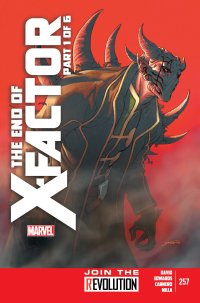
By Jeb D.
“The End of X-Factor” begins, as Peter David winds down his special corner of the X-verse with the first installment of a series of tales focused on individual members of the X-Factor team. Having pushed the reset button on the “Hell War”, with only the members of X-Factor aware of its cataclysmic events, the city of Marrakesh provides the backdrop for a standalone Layla Miller adventure. While I give David credit for greatly developing this rather one-note character from House of M, she works better set against the dynamics of a team: her “I know stuff” grates when she has no one to talk to but the reader, and in this story, she serves as little more than a commentator.
Jamie Madrox, still in his demon form from the Hell War, is the silent Macguffin of this story, in which a young man believes that the transformed Madrox is a djinn, who will do his bidding, in the sort of “careful what you wish for” story whose model goes back at least to O.Henry or Saki. Layla’s participation is mostly limited to giving warnings to the boy and his uncle about the danger of messing with mystical forces, and providing the bleak summation to the story as she resumes her quest to restore her husband to his normal mutant form. It’s a decent enough story, but doesn’t really benefit much from being told in the context of X-Factor.
Art has never been the selling point of David’s X-Factor; in fact, it’s too often felt like a proving ground for new talent, or last-minute fillins, giving the entire run a sort of patchwork quality. The use this time of two pencillers, Neil Edwards and Carmen Carnero, with inks from Jay Leisten, is handled reasonably smoothly, and they all get the job done serviceably enough.
X-Factor has been one of Marvel’s most pleasant change-of-pace titles for the past few years, and while I’m sorry to see it end, the rather conventionally “epic” Hell War storyline did suggest that it might be time for David to take a fresh look at his favorite Marvel characters; I’m less worried about losing X-Factor than I am wondering whether Marvel will be inclined to give David the leeway to make his next project as rewardingly individual and idiosyncratic as this series has been at its best.
Rating: 




Out of a Possible 5 Stars